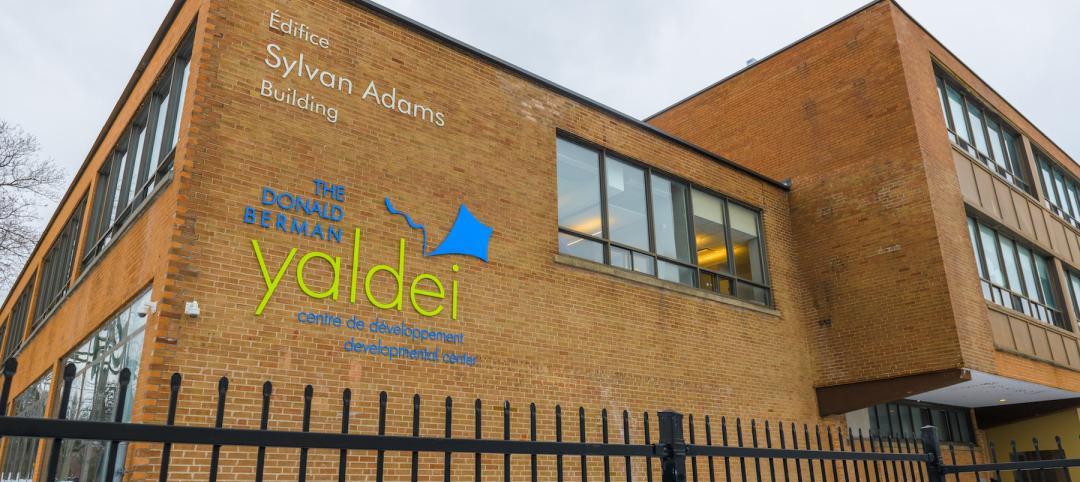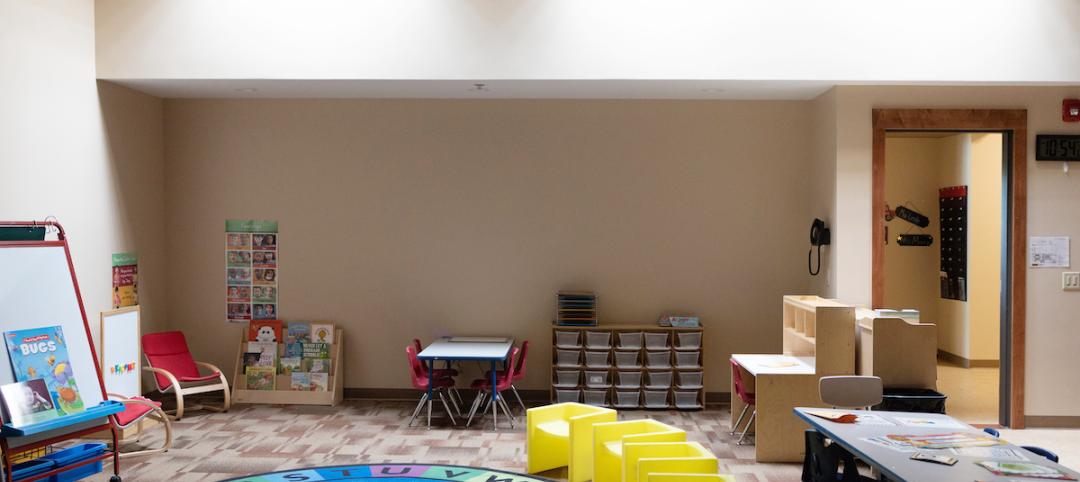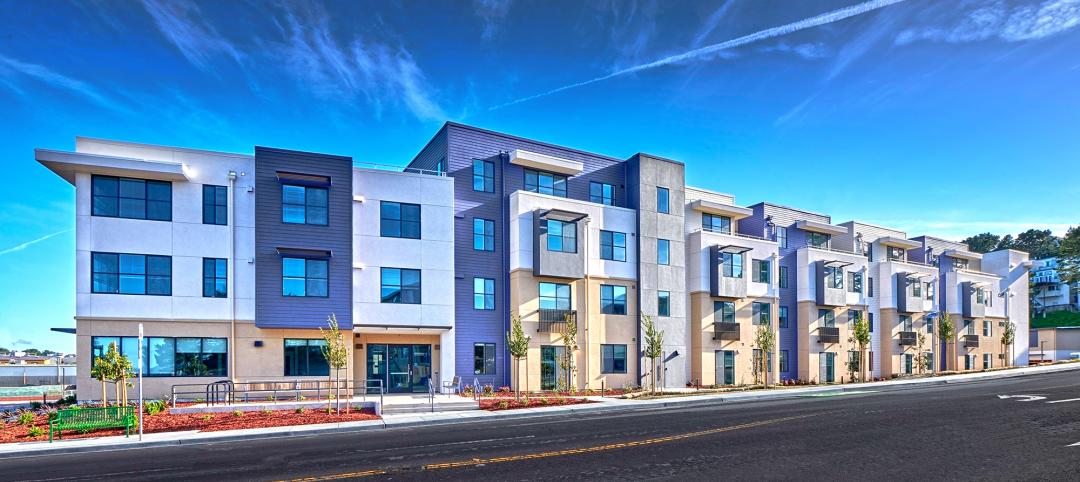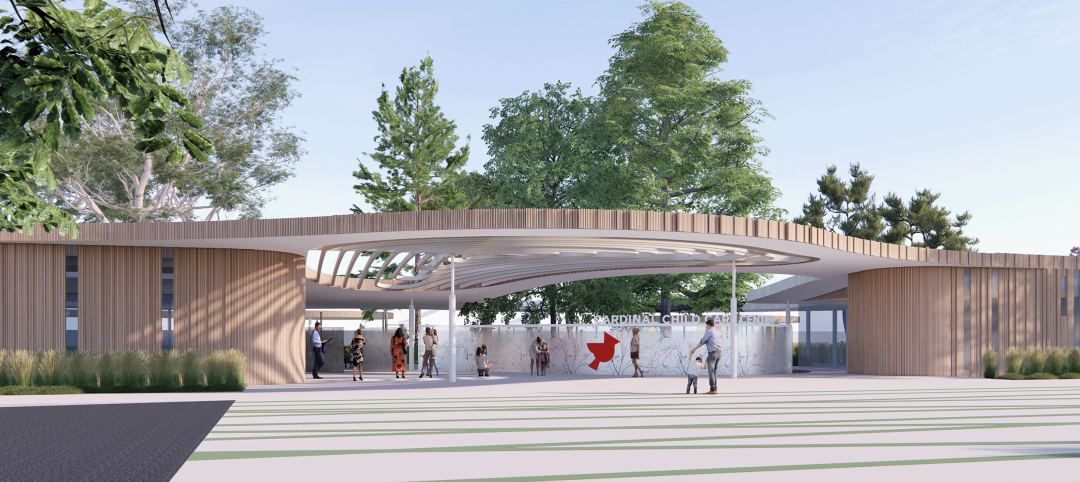Add the explosion in the number of school-aged kids nationally to the glut of huge, vacant stores in many communities and what do you get? Big boxes being turned into schools. For districts facing population pressure, these empty retail buildings can be the key to creating classrooms quickly, and at a significant cost advantage.
SchenkelShultz Architecture, with 10 offices nationally and six in Florida, has done several such conversions. Partner Dan Tarczynski, AIA, of Orlando, says big boxes provide big benefits, including prime locations: "Retailers look for the right housing demographics. When you design a school, this is also the case. When these properties become vacant, they are already in the right spot."
In 2002, SchenkelShultz and design/build partner Centex Rooney transformed unused multipurpose space at Tupperware's corporate campus into a performing arts high school for Osceola County. The district is now revamping an 88,500-sf Kmart for a ninth-grade center in Kissimmee. "The school district needs to be flexible as we look at our future school construction plans," says school board chair Tom Greer. "If there are other big boxes that become available that are the right fit, we may replicate this effort."
A demographic dilemma
The baby boomers' offspring are crowding K-12 facilities all over America. High-immigration areas are doubly squeezed. Schools are shoehorning classrooms into gyms and slipping modular units into playground space. In Chicago, reports of classes held in hallways a decade ago sparked a massive construction initiative; nine years and $2.3 billion later, the district still has $2.5 billion in unfunded capital needs.
Nationwide, more than $20 billion of K-12 construction was completed in 2004, with 80% going for new schools or additions, according to the 10th Annual School Construction Report/2005 (published by School Planning & Management magazine with Market Data Retrieval). Regions experiencing double-digit annual school construction spending growth include the New York-Pennsylvania-New Jersey area, Texas and surrounding states, and California-Nevada-Arizona.
This pace is particularly acute in Florida, where the warm climate and relatively low living costs continue to draw immigrants and interstate migration. "It's predicted that, over the next 20 years, there will be six million people moving to Florida, which averages out to the need for 750 new classrooms a year for 20 years," says SchenkelSchultz's Tarczynski. Lee County alone plans to build 45 schools in the next 10 years.
Compounding the capacity problem is a push toward smaller class size. By state law, Florida schools have just five more years to reduce class sizes to as low as 18 for grades K-3. Hurricane damage has further decreased classroom availability in some Florida towns.
Until recently, Florida districts at least enjoyed modest construction costs. But prices have ballooned with the worldwide materials shortage. "The numbers have gone up 25–30% just in the past year," says Kassey Teimouri, a project designer in SchenkelShultz's Tampa office.
Scheduling is another stress factor. It takes 18–24 months to build a new school, says Tarczynski. That's too slow if a district needs more than 40 or 50 new classrooms every couple of years.
Great location, greater size
Given this convergence of factors, empty big boxes inevitably began to look like schools to district officials. Due to retail restructuring, it's fairly easy to find boxes sized from 40,000 to 200,000 sf. "The retailers here are just getting bigger," says Tarczynski. "If their first store was 40,000 sf, they're building something that's 60,000 sf. If they had 60,000 sf, they now want 80,000 sf."
Big boxes are invariably situated on major arteries, with ample lots for vehicle staging and playgrounds. The surrounding neighborhoods, flush with growing families, usually need more schools, but plans may be hampered by a lack of available building sites or the NIMBY syndrome—"not in my backyard," please.
Location drove the big-box decision for the School District of Lee County, on the state's west coast. "It's very marshy here, and it's hard to find property of sufficient size in the zones where we need new schools," says Michael Smith, the district's director of planning, growth, and school capacity. This fall, Lee County will open two "staging schools" of about 115,000 sf, adapted from Kmarts in Lehigh Acres and Estero. The buildings will serve elementary and secondary students while new facilities are being constructed, and will ultimately become permanent schools.
Big boxes also offer important structural advantages, according to SchenkelShultz's Tarczynski. The open floor plate has a typical bay size of 30×30 to 30×40 sf, ideal for accommodating classrooms. And conversion reduces the need for new materials. The firm's clients have saved 30–35% compared to average new-school costs of $110–$130 per sf.
Districts reap a sustainability bonus when they transform asphalt into green space and recycle existing building stock. Even more appealing for most clients is the 50% reduction in construction time, with a new facility completed in less than a year.
Conversion challenges
Along with its pluses, the big-box strategy has its share of hurdles:
Infrastructure. Adequate HVAC capacity might be available, but the climate zoning is usually wrong. "Because you're changing the building use, you have to upgrade at least some of the mechanical infrastructure," says project designer Teimouri. If overhead space is insufficient for a gym, you might have to reconfigure the roof. Also possible: additional plumbing to support more sinks and toilets, roof membrane replacement, and upgrades for hurricane resistance.
Due diligence. Accurate as-built information is often hard to find, Teimouri says, but it's crucial for producing solid cost estimates and avoiding nasty surprises.
Daylighting. The boxes' squarish footprint makes it tricky to maximize daylight. A typical solution is to put classrooms at the perimeter and core facilities at the center. Clerestories, skylights, and interior windows can channel light deep into the interior.
Wayfinding. "We try to create colors or forms that help students orient themselves," Tarczynski says. "You want maximum efficiency, but you don't want students facing identical corridors over and over."
Image. With a trend toward smaller learning facilities, designers must fight the perception that a converted school will be perceived as a warehouse, with a commensurate loss of prestige. "Will it be thought of as the 'Kmart school'? asks Teimouri. "How do you change the image? This is not a big problem from an architectural standpoint, but it is definitely something to consider."
SchenkelSchultz's ability to meet the challenge may be best illustrated by its conversion of a 40,000-sf Sports Unlimited for Winter Park's Geneva School, a classical academy. The private K-12 school, half empty when it opened in 2003, is now full and thriving.
Though Geneva would eventually like to create a larger new facility on expansive acreage, the conversion has been an excellent stopgap, according to Crosland Stuart, a member of the school's board of governors. The design has boosted the school's visibility, spirit, and enrollment, she says. "We are way ahead of our growth projections, and quite honestly, I'd credit this building for some of that."
Related Stories
K-12 Schools | Feb 18, 2023
Atlanta suburb opens $85 million serpentine-shaped high school designed by Perkins&Will
In Ellenwood, Ga., a southeast suburb of Atlanta, Perkins and Will has partnered with Clayton County Public Schools and MEJA Construction to create a $85 million secondary school. Morrow High School, which opened in fall 2022, serves more than 2,200 students in Clayton County, a community with students from over 30 countries.
K-12 Schools | Feb 11, 2023
An elementary school in Canada for intellectually challenged kids completes a three-year-long facelift
Last fall, the Yaldei School in Montreal, Quebec, which provides education and therapy to children ages 4 through 16 with intellectual disabilities, completed a $4.5 million renovation of the three-story former parochial school that it had moved into in 2016. The goal of this project, by the firm Stendel + Reich Architecture, was to create spaces that relieve students’ anxiety and make things fun.
Giants 400 | Feb 9, 2023
New Giants 400 download: Get the complete at-a-glance 2022 Giants 400 rankings in Excel
See how your architecture, engineering, or construction firm stacks up against the nation's AEC Giants. For more than 45 years, the editors of Building Design+Construction have surveyed the largest AEC firms in the U.S./Canada to create the annual Giants 400 report. This year, a record 519 firms participated in the Giants 400 report. The final report includes 137 rankings across 25 building sectors and specialty categories.
Giants 400 | Feb 6, 2023
2022 Reconstruction Sector Giants: Top architecture, engineering, and construction firms in the U.S. building reconstruction and renovation sector
Gensler, Stantec, IPS, Alfa Tech, STO Building Group, and Turner Construction top BD+C's rankings of the nation's largest reconstruction sector architecture, engineering, and construction firms, as reported in the 2022 Giants 400 Report.
K-12 Schools | Jan 25, 2023
As gun incidents grow, schools have beefed up security significantly in recent years
Recently released federal data shows that U.S. schools have significantly raised security measures in recent years. About two-thirds of public schools now control access to school grounds—not just the building—up from about half in the 2017-18 school year.
ProConnect Events | Jan 16, 2023
6 more BD+C ProConnect Events in 2023 – The videos show why you should participate
ProConnects bring building product manufacturers and suppliers together with architects, contractors, builders, and developers to discuss upcoming projects and learn about new products and technical solutions.
K-12 Schools | Dec 23, 2022
Vacant Target store in Minnesota turned into early childhood education center
Lincoln School, a former 90,000-sf Target retail store in Fergus Falls, Minn., was repurposed into Independent School District 544’s newest campus.
Multifamily Housing | Dec 21, 2022
Bay Area school district builds 122 affordable apartments for faculty and staff
The 122 affordable apartments at 705 Serramonte, Daly City, Calif., were set aside not for faculty and staff at Jefferson Union High School District.
K-12 Schools | Dec 20, 2022
Designing an inspiring, net zero early childhood learning center
LPA's design for a new learning center in San Bernardino provides a model for a facility that prepares children for learning and supports the community.
Sponsored | Resiliency | Dec 14, 2022
Flood protection: What building owners need to know to protect their properties
This course from Walter P Moore examines numerous flood protection approaches and building owner needs before delving into the flood protection process. Determining the flood resilience of a property can provide a good understanding of risk associated costs.















